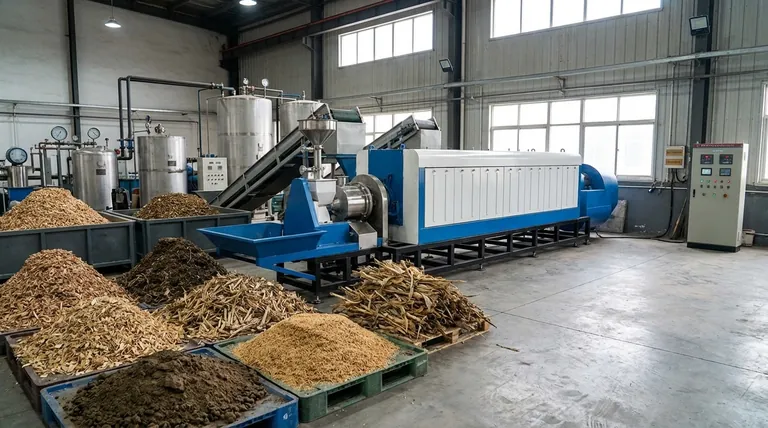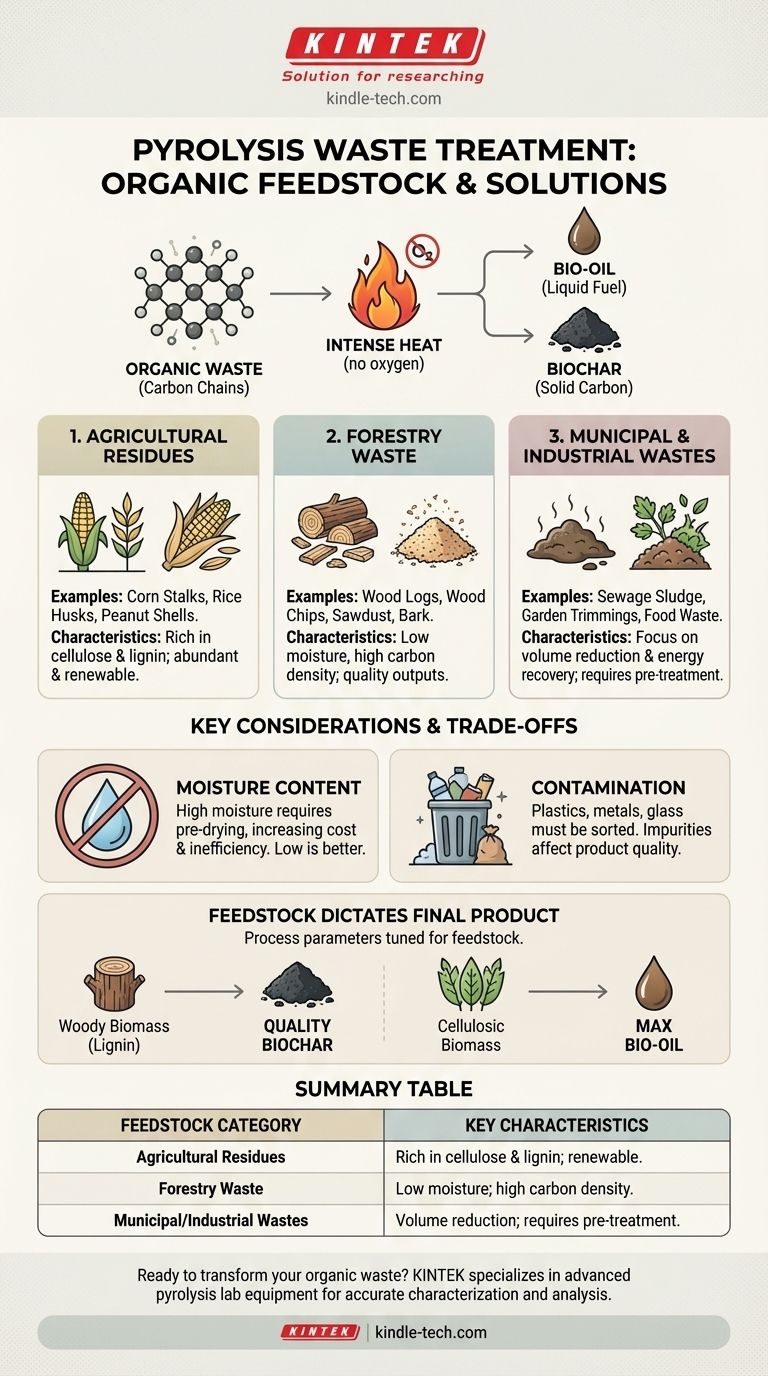At its core, pyrolysis is designed to treat virtually any organic waste. This thermal decomposition technique works by heating carbon-based materials in an oxygen-starved environment, breaking them down into valuable products like bio-oil and biochar. Its versatility makes it suitable for a vast range of residues from agriculture, forestry, and municipal waste streams.
The fundamental requirement for pyrolysis feedstock is that it must be organic. While the technology can handle a wide variety of materials, the ultimate success and efficiency of the process are determined by the specific characteristics of the waste, such as its moisture content, density, and chemical composition.

The Principle: Why Organic Matter is Key
Pyrolysis is fundamentally a process of chemical decomposition driven by heat. Understanding what makes a material suitable begins with this core concept.
The Role of Carbon Chains
All organic materials, from wood chips to corn stalks, are built from long chains of carbon atoms. The goal of pyrolysis is to break these complex chains into simpler, more valuable molecules.
The intense heat, applied without the presence of oxygen, prevents the material from combusting (burning). Instead, the chemical bonds holding the molecules together vibrate and shatter, reforming into gas, liquid (bio-oil), and solid (biochar) products.
Major Categories of Pyrolysis Feedstock
While the range is broad, suitable wastes can be grouped into a few primary categories based on their origin.
Agricultural Residues
This is one of the most common and abundant sources of feedstock. It includes the leftover materials from farming and food processing.
Examples include corn stalks, rice husks, peanut shells, coffee shells, and olive seeds. These materials are rich in cellulose and lignin, making them ideal for conversion.
Forestry Waste
The timber and paper industries generate significant volumes of organic waste that are perfectly suited for pyrolysis.
This category covers materials like wood logs, wood chips, sawdust, tree branches, bamboo, and tree bark. Their low moisture content and high carbon density often lead to high-quality outputs.
Municipal and Industrial Wastes
Pyrolysis also offers a powerful solution for managing specific waste streams generated by communities and industries.
This includes organic solid waste like garden trimmings and certain food wastes. A key application is also the treatment of sewage sludge, which reduces its volume and recovers energy.
Key Considerations and Trade-offs
Simply being "organic" is not the only factor. The practical efficiency of a pyrolysis plant depends heavily on the quality and consistency of its feedstock.
The Impact of Moisture Content
High moisture content is a significant challenge. A large amount of energy must be spent to boil off water before the pyrolysis process can even begin, which can make the entire operation inefficient or uneconomical.
Many systems require the feedstock to be pre-dried to an optimal moisture level, adding a step and cost to the process.
The Problem of Contamination
The purity of the waste stream is critical. Non-organic contaminants like plastics, metals, glass, and construction debris can damage equipment or poison the final products, rendering them useless or hazardous.
Effective sorting and pre-treatment are essential for any successful pyrolysis operation that uses mixed municipal or industrial waste.
How Feedstock Dictates the Final Product
The type of waste you put in directly influences the type of products you get out.
For example, woody biomass tends to produce a higher yield of quality biochar, while materials with different chemical structures might yield more bio-oil. The process parameters—like temperature and time—are often tuned specifically for the feedstock being used.
Making the Right Choice for Your Goal
Selecting the right waste material is about matching an available resource to your desired outcome.
- If your primary focus is producing biochar for soil amendment: Dry, woody biomass like wood chips or nutshells is often the ideal choice due to its high lignin content.
- If your primary focus is maximizing bio-oil for fuel: Feedstocks with high cellulose content, such as agricultural grasses or certain types of forestry residue, are typically preferred.
- If your primary focus is waste management and volume reduction: The technology can be adapted for more challenging materials like sewage sludge, where the goal is destruction and energy recovery rather than producing a specific high-value product.
Ultimately, understanding the composition of your available waste stream is the first step toward a successful pyrolysis project.
Summary Table:
| Feedstock Category | Common Examples | Key Characteristics |
|---|---|---|
| Agricultural Residues | Corn stalks, rice husks, peanut shells | Rich in cellulose and lignin; abundant and renewable. |
| Forestry Waste | Wood chips, sawdust, tree bark | Low moisture content; high carbon density for quality outputs. |
| Municipal/Industrial Wastes | Sewage sludge, garden trimmings, food waste | Focus on volume reduction and energy recovery; requires pre-treatment. |
Ready to transform your organic waste into valuable resources? KINTEK specializes in advanced lab equipment and consumables for pyrolysis research and analysis. Whether you're developing a new process or optimizing an existing one, our solutions help you accurately characterize feedstocks and analyze bio-oil and biochar outputs. Let our expertise support your project from the lab to full-scale implementation. Contact our specialists today to discuss your specific needs and discover the right equipment for your pyrolysis goals.
Visual Guide

Related Products
- Electric Rotary Kiln Small Rotary Furnace Biomass Pyrolysis Plant
- Vacuum Sealed Continuous Working Rotary Tube Furnace Rotating Tube Furnace
- Vacuum Hot Press Furnace Heated Vacuum Press Machine Tube Furnace
- Vacuum Heat Treat and Molybdenum Wire Sintering Furnace for Vacuum Sintering
- Lab-Scale Vacuum Induction Melting Furnace
People Also Ask
- How is energy converted into biomass? Harnessing Nature's Solar Power for Renewable Energy
- Is pyrolysis viable? A Guide to Economic, Technological, and Environmental Success
- What are the products of pyrolysis of biomass? Unlock Bio-Char, Bio-Oil, and Syngas
- What are the reactions involved in pyrolysis of biomass? Unlock the Chemistry for Tailored Bio-Products
- What are the conditions for biomass pyrolysis? Optimize Temperature, Heating Rate & Time



















